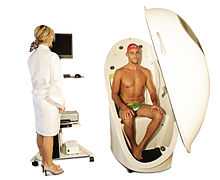Body composition
In physical fitness, body composition is used to describe the percentages of fat, bone, water and muscle in human bodies. Because muscular tissue takes up less space in our body than fat tissue, our body composition, as well as our weight, determines leanness. Two people of equal height and body weight may look completely different from each other because they have a different body composition.
Measuring body composition
Body composition (particularly body fat percentage) can be measured in several ways. The most common method is by using gun calipers to measure the thickness of subcutaneous fat in multiple places on the body. This includes the abdominal area, the subscapular region, arms, buttocks and thighs. These measurements are then used to estimate total body fat with a margin of error of approximately four percentage k1 points.
Another method is bioelectrical impedance analysis (BIA), which uses the resistance of electrical flow through the body to estimate body fat.
Assessment of somatic (skeletal) protein is typically determined by simple measurements and calculations including mid arm circumference (MAC), mid arm muscle circumference (MAMC), and creatinine height ratio (CHI). Creatinine height ratio is calculated as 24 hour urine creatinine multiplied by 100 over the expected 24 hour urine creatinine for height. This calculation results in a percentage which can indicate protein depletion.

Body composition measurement with Dual energy X-ray absorptiometry (DEXA) is used increasingly for a variety of clinical and research applications. DEXA Scan is a medical grade test and considered the Gold Standard in body composition testing over 99% accurate. Total body or estimated total body scans using DEXA give accurate and precise measurements of BMD and body composition, including bone mineral content (BMC), bone mineral density (BMD), lean tissue mass, fat tissue mass, and fractional contribution of fat.[1]
A technique for measuring body composition has been developed using the same principles as under water weighing. The technique uses air, as opposed to water and is known as Whole-Body Air Displacement Plethysmography (ADP). Subjects enter a sealed chamber that measures their body volume through the displacement of air in the chamber. Body volume is combined with body weight (mass) in order to determine body density. The technique then estimates the percentage of body fat and lean body mass (LBM) through known equations (for the density of fat and fat free mass).
These measurements are extremely reproducible, making them excellent for monitoring pharmaceutical therapy, nutritional or exercise intervention, sports training and or other body composition altering programs. They are also fast, simple, non-invasive, and expose the subject to a level of x-rays less than that of a cross-country flight. DEXA exams provide both total body and up to 14 regional (trunk, individual arms & legs, android, gynoid, etc.) results.
Body Composition is also estimated using cross-sectional imaging methods like magnetic resonance imaging (MRI) and computed tomography (CT). Since MRI and CT give the most precise body composition measures to-date, many pharmaceutical companies are very interested in this new procedure to estimate body composition measures before and after drug therapy especially in drugs that might change body composition.
Ultrasound has also been used to measure subcutaneous fat thickness, and by using multiple points a measurement of body composition can be made. Ultrasound has the advantage of being able to also directly measure muscle thickness and quantify intramuscular fat.
Body Composition can also be measured using the skinfold test, this is done using a tool called a caliper. You can do this in nine steps,
- Take measurements on the right side of the body.
- Mark client up.
- Pinch skin (KM) above mark
- Pull fat away from muscles
- Place caliper halfway between top and bottom of mark
- Allow caliper to settle (1–2 seconds)
- Take reading — repeat 15 seconds
- Add up total (4) — average
- Calculate body fat %
See also
References
- ↑ Kiebzak GM, Leamy LJ, Pierson LM, Nord RH, Zhang ZY (2000). "Measurement precision of body composition variables using the lunar DPX-L densitometer". J Clin Densitom 3 (1): 35–41. doi:10.1385/jcd:3:1:035. PMID 10745300.